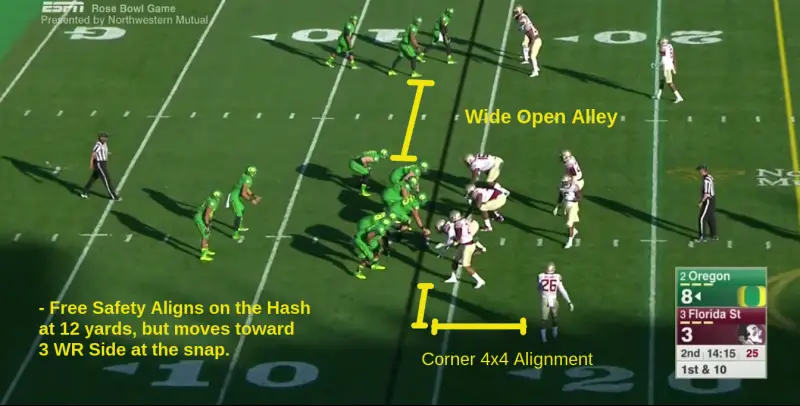The late, great Bill Walsh, former head coach during the glory days of the 49ers with Joe Montana and Jerry Rice, made a living showing opponents something they hadn’t seen on tape in the days leading up to the game. Oregon is no different.
As a staff, Oregon coaches love to talk about how simple their scheme is, and how fundamentals are more important than scheme. However, even the simplest schemes need at least a dash of deception now and then, otherwise they run the risk of being too predictable and therefore ineffective. So just about every week, the Ducks will usually come out with one or two different things they haven’t shown on film before. Sometimes it’s just a new formation or two, but there’s always something to keep the defense on its toes.
Last week we talked about the importance of formations when it comes to putting together an offensive game plan, but today we’re going to discuss things from the opposite point of view. What happens defensively when an offense lines up in something it hasn’t shown before?
We’ll take a couple of plays from the Rose Bowl and talk about it.
The Formation
First, let’s talk about the formation itself. What stands out to you?
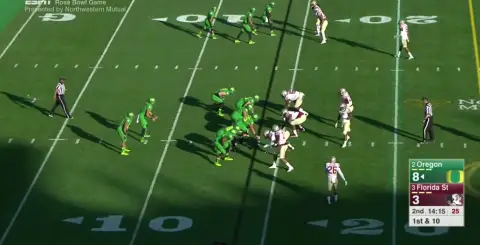
This unusual formation allowed Oregon to put a lot of stress on the Florida State defense
One of the biggest things that should stick out is that one of the wide receivers is not eligible to catch a pass, by virtue of his alignment. Oregon plays a little fast and loose with the definition of “on the line” in the photo above, but the long and short of it is that by lining up on the line of scrimmage, the inside receiver makes himself ineligible to catch a pass. By rule, the offense must line up with at least seven men on the line of scrimmage, and only the widest man on each end of the line is eligible to catch a pass.
The wide alignment of the three receivers creates a “bunch” look to the opposite side of the field, but it also means that Oregon can line up with the tight end off the line of scrimmage. As a result, the TE can motion back and forth, and he can also cross the formation at the snap to block someone or run a pass route. The wide alignment of the receivers to the field makes the safeties on the field have to declare what they’re going to focus on, so that they have a tough time playing both sides of the formation.
The question though, is how does a defense adapt to something it’s never seen before? It’s one thing to be able to coach your guys up on the sideline in between drives when you can draw something up on the whiteboard, but what about the first time the offense comes out in something brand new, and you don’t have an opportunity to review it with your players? In that moment, discipline and fundamentals must take over if you are to succeed, and two of the most important parts of any defense are maintaining proper levels and gap control.
Levels
One thing that’s often ignored when diagnosing a play during a game, but extremely important for any defense, is to have levels.
What does that mean? It means that there needs to be the right amount of depth and width to the alignments of the players, so that if an offensive player breaks through the defensive line, there needs to be someone in proper position to either bring him down, or force him back toward other defenders. For example, you might think that if you’re trying to stop the run, it would make sense to put every defender up righst at the line of scrimmage, but that’s not always true. Even if for the sake of the example, we made it illegal for the offense to throw a pass, it would still be a good idea to put a few defenders back at linebacker-depth, and maybe even one safety back at about ten yards.
One reason is that while it would be great if every defender always executed his assignment correctly 100% of the time, that’s just not realistic. You’re going to lose some one-on-one battles during the course of a game, and you want to have someone back behind the defensive line who is athletic enough and in a good enough position to make up for mistakes. The other reason is that giving yourself depth on defense also prevents opposing offenses from getting outside to the perimeter too easily. Putting defenders at linebacker and safety depths gives them great angles to chase down runs and throws to the perimeter, whereas if everyone were lined up at the same depth, if you get to the edge on offense, all you have to do is beat one man and you’re gone.
Let’s take a look at a perfect example of that on this first play. The Oregon game plan going in was to use this formation to get its running backs matched up with the corner, and that’s just what happened. For all you aspiring play callers out there, anytime you can force corners to make tackles consistently, you’re doing something right.

Let’s take a closer look at the corner’s alignment at the bottom of the diagram. We can see he’s about four yards deep off the line of scrimmage, and it looks like he’s about four to five yards wide of the offensive tackle to that side. This is a common alignment to formations that are either unbalanced like this one, or even have a tight end lined up to that side.
As we can also see, the three-receiver side forces the defense to commit three men to that side — a corner, and two of the three safeties on the field. As was discussed in a previous analysis, Florida State plays a three-safety package as part of its base scheme in order to put more speed on the field and give the safeties more ability to adjust to different formations.
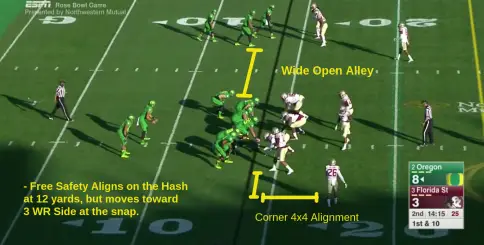
We can see the corner and (the shadow of the) free safety playing with good leverage in this picture.
At the snap, the TE will come across the formation ready to either kick out the defensive end if he comes up the field, or climb to the second level if the DE closes and stays tight to the butt of the offensive tackle (which we’ll go into greater detail about in the next example). Mariota will read the defensive end just like on any other zone read play and react accordingly.
At the same time, the play side corner does a great job of staying where he’s supposed to and not overreacting.

The TE comes across the formation and reads the end man on the line, just like the QB.
As you can see, the corner maintains his leverage and depth, and if it wasn’t for him, this could’ve easily been another TD by Oregon, and the game may have gotten out of hand even earlier. If, for example, he had come up to the line of scrimmage at the first sign of a run, he’d have vacated the hole the running back came through, leaving no one but the free safety to make the tackle to that side of the field.

Look at the size of the gap that the TE block creates on the edge. The corner ends up one on one with the back in this case, and if he played with poor leverage, this could be a TD.
This is obviously just one example, but it’s a good one. Think about it: Oregon comes out in a brand new formation, and if it weren’t for the dedication to sound defensive principles, Florida State could’ve easily panicked, or just simply been caught out of position. Instead, they managed to keep the damage to a minimum and live to play another day.
Gap Control
Frequent readers of this site are familiar with the basic idea of offensive gaps and that in most schemes, each member of the defense has a particular gap he is responsible for. This affects how the defensive end to the read side will play against what he sees, since on this play, he’s got another D-lineman occupying the gap to his inside. An early thing to point out is that once again, the corner to the near side of the formation keeps this play from turning into something bigger. As the TE comes around and starts climbing to the CB, the defender does his best to keep outside leverage, which keeps Mariota from breaking too easily outside, and allows time for the rest of the defense to get there.

Great positioning by the cornerback to this side keeps Mariota from turning a good play into a fantastic play.
Now lets take a look at the end zone view below. As you can see, the B and C gaps to the right side are occupied by defensive linemen. This means that if the offensive tackle “blocks down” to the defensive tackle like he does on this play, he’ll run right into the defensive tackle who is lined up just off the right shoulder of the right guard.
The biggest issue is space, or rather, the lack of it. If there were an “open” gap to the inside of the defensive end, he and the linebacker would have to exchange responsibilities, where the LB would “scrape” to the QB and the DE would “close” by turning his shoulders, coming tight off the butt of the offensive tackle, and chasing the dive player. He wants to eliminate any open space inside so that there are no open running lanes in the interior of the formation. He is essentially sealing off the B-gap, since now the tackle has moved, the edge of the formation has now moved as well.
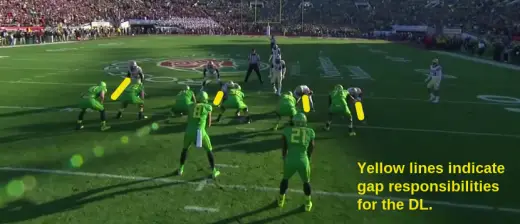
The DE to the side of the back can afford to play much more aggressively upfield because the B gap next to him is also filled with a D-Lineman.
Since that doesn’t happen, and the DE has a fellow defensive lineman to his inside, the B-gap is taken care of and he can now concentrate much more aggressively on his own gap.
Once the ball is snapped, the defensive end to the read side doesn’t quite turn his shoulders, but he does attach himself to the offensive tackle and try to disrupt his blocking assignment, so that there isn’t a whole lot of running room inside. Mariota’s instructions on this play during the game appear to be “keep it unless you can’t” or in other words, unless the DE is clearly coming up the field, keep the ball and take your chances on the edge.
This type of coaching point is very common for option teams, especially when your QB is the best player on the field. If there’s one thing this Oregon staff knows how to do, it’s get the ball into the hands of its best players.

The DE closes down the line, so without a target obstructing his climb to the second level, the TE moves on to the next defender he sees. In this case, it’s the corner playing on the edge.
We see the TE coming across the formation, and passing the DE by, since he’s staying tight to the butt of the offensive tackle. He’ll then start to climb to the next level, and in this case, he’ll go after the corner, trying to take him whichever way is the easiest. What he wants to do is plow the road for Mariota, and open up a big hole to the outside so there’s lots of room to run. Instead, the corner does a great job of maintaining outside leverage, while at the same time not just easily ceding ground without a struggle.
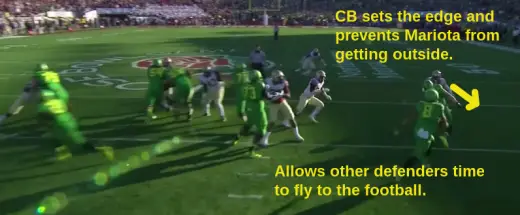
The CB to the boundary side does a great job of setting the edge, preventing Mariota from getting outside, and allowing the rest of the defense to fly to the football.
As a result, Mariota spends much of the play running horizontally instead of vertically, and that gives the rest of the defense time to get to the ball and force him out of bounds on a play that, once again, would’ve gone the distance if it weren’t for the discipline of the corner to boundary side.
Conclusion
As we’ve seen over the past few weeks, the use of specific formations and alignments are crucial to the Oregon coaching staff’s putting together a game plan, and by now, opponents should always expect that the Ducks will come out with one or two small things that they’ve never seen.
As a coach, there’s no possible way you can predict every single play and formation that the opponent will have in its game plan, so your only choice is to drill fundamentals each day and make sure your defensive guys understand their fit in the scheme.
Alex Kirby
Oregon Football Analyst for CFF Network/FishDuck.com
Indianapolis, Indiana
Featured Image From Video
Alex Kirby (Writer and Football Analyst) worked several seasons as an assistant football coach at the high school and college levels and is the author of Speed Kills: Breaking Down the Chip Kelly Offense, now available HERE.

